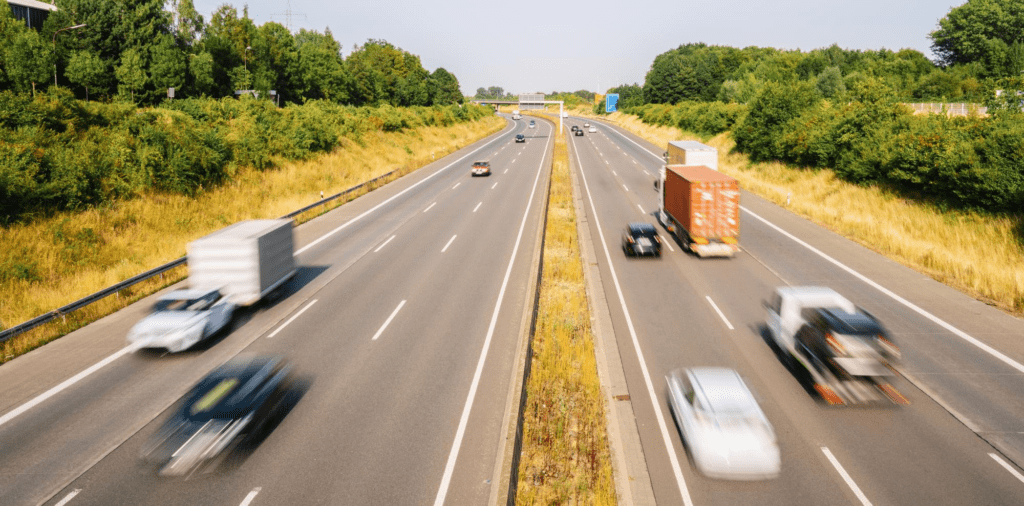
Motorway driving can be a daunting experience for new drivers. However, understanding the key aspects of entering, navigating, and exiting motorways can make this task more manageable and less stressful.
This comprehensive guide aims to equip UK learner drivers with the knowledge and confidence needed for safe and efficient motorway driving.
Entering the Motorway
Preparing to Join the Motorway
Before you even set off, ensure that your vehicle is in good condition. Check your tyres, fuel level, oil, coolant, and lights.
Familiarise yourself with the route and any specific motorway exits or junctions you need to take. It’s also beneficial to be aware of the weather conditions as they can significantly affect your driving.

Image source: Geograph
When approaching the motorway, you will usually be on an A-road or a minor road. Pay attention to the signs that indicate the motorway entrance.
These signs are typically blue with white lettering. Before you reach the slip road, make sure you have selected the correct lane and are aware of other vehicles around you.
Using the Slip Road
The slip road is designed to help drivers accelerate to a speed that matches the flow of traffic on the motorway.
As you enter the slip road, start accelerating and check your mirrors. The goal is to reach a speed that allows you to merge seamlessly with the traffic on the motorway.
It’s important to use the entire length of the slip road to build up your speed. Do not stop or slow down on the slip road unless absolutely necessary, as this can create a hazardous situation. Instead, keep a steady pace and prepare to merge safely.
Merging Safely with Traffic
Merging onto the motorway requires careful observation and timing. Check your mirrors and look over your shoulder to check your blind spot. Signal your intention to join the motorway well in advance.
The key is to find a gap in the traffic that you can merge into without causing other vehicles to brake or swerve.
If necessary, adjust your speed slightly to fit into the flow of traffic. Once you have identified a suitable gap, move smoothly into the left lane.
Assessing Traffic Speed
When you first join the motorway, it can be challenging to judge the speed of other vehicles.
Traffic on the motorway typically moves faster than on other roads, and it can take some time to adjust. Use the speed of the vehicles in the left lane as a reference.
It’s crucial to maintain a safe following distance. The two-second rule is a good guideline – ensure there is at least a two-second gap between you and the vehicle in front.
In adverse weather conditions, increase this distance to account for reduced visibility and longer stopping distances.
Common Mistakes to Avoid on Motorways
Lanes on the Motorway
Understanding the purpose of each lane on the motorway is essential for safe and efficient driving.
The left lane is the primary lane for general driving. The middle lane and right lane (or outside lane) are primarily for overtaking slower vehicles.
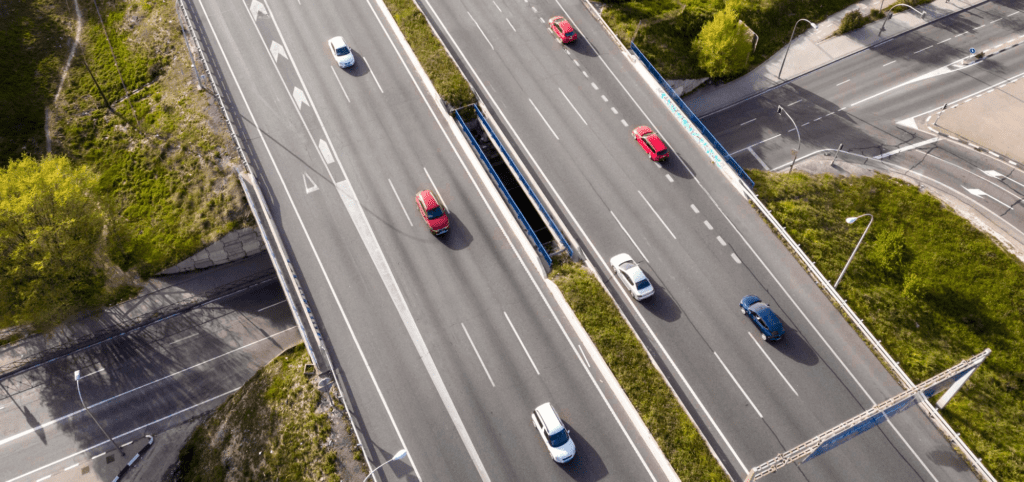
Understanding Lane Usage
One of the most common mistakes new drivers make is incorrect lane usage. Remember, the left lane is for regular driving.
You should only use the middle and right lanes for overtaking. Once you have overtaken a vehicle, you should return to the left lane as soon as it is safe to do so.
Lane Discipline
Maintaining good lane discipline is crucial. Stay in the left lane unless you are overtaking another vehicle.
Hogging the middle or right lanes can cause congestion and frustration among other drivers. It is also illegal and can result in fines and points on your licence.
When changing lanes, always signal your intentions clearly and in advance. Check your mirrors and blind spots before making any manoeuvre.
Move smoothly and avoid sudden lane changes, as these can startle other drivers and lead to accidents.
Overtaking Procedures
When you need to overtake a slower vehicle, check your mirrors and blind spot to ensure the middle or right lane is clear.
Signal your intention to move into the overtaking lane. Accelerate smoothly and overtake the vehicle without exceeding the speed limit.
Once you have passed the slower vehicle, check your mirrors again. If the left lane is clear, signal your intention to return to it.
Move smoothly back into the left lane, maintaining a safe distance from the vehicle you have overtaken.
Returning to the Left Lane
Returning to the left lane after overtaking is a critical aspect of motorway driving. It helps maintain the flow of traffic and reduces the risk of collisions.
Once you have overtaken a vehicle, check your mirrors and blind spot to ensure it is safe to move back to the left lane.
Signal your intention and move smoothly back into the lane, ensuring there is enough space between you and the vehicle behind.
Middle and Outside Lanes
The middle and outside lanes should only be used for overtaking slower traffic. Many new drivers mistakenly believe that the middle lane is for general driving, but this is incorrect.
Using the middle lane when the left lane is clear can cause unnecessary congestion and frustration for other drivers.
If you find yourself in the middle or outside lane and the left lane is clear, move back to the left lane as soon as it is safe to do so.
This practice is known as “lane discipline” and is crucial for maintaining a smooth and efficient flow of traffic on the motorway.
The Highway Code
Importance of the Highway Code
The Highway Code is an essential guide for all road users in the UK. It contains important rules, advice, and information designed to promote road safety and ensure smooth traffic flow.
For learner drivers, understanding and adhering to the Highway Code is crucial, especially when driving on motorways where traffic conditions and speeds can be more challenging.
Distance and Lane Discipline (Rule 126 and Rule 264)
- Rule 126 of the Highway Code focuses on safe distances. Maintaining a safe distance between your vehicle and the one in front is critical to avoid collisions.
- The two-second rule is a reliable measure: ensure there is at least a two-second gap between you and the vehicle ahead. In adverse weather conditions, this gap should be increased to four seconds.
- Rule 264 addresses lane discipline on the motorway. It states that you should keep to the left lane unless overtaking.
The middle and right lanes should only be used for overtaking slower-moving traffic and you should return to the left lane as soon as it is safe to do so.
Good lane discipline helps in reducing traffic congestion and minimising the risk of accidents.
Using Signs and Symbols
Understanding and correctly interpreting signs and symbols on the motorway is vital for safe driving.
Motorway signs provide information about speed limits, lane closures, upcoming exits, and other important traffic instructions.
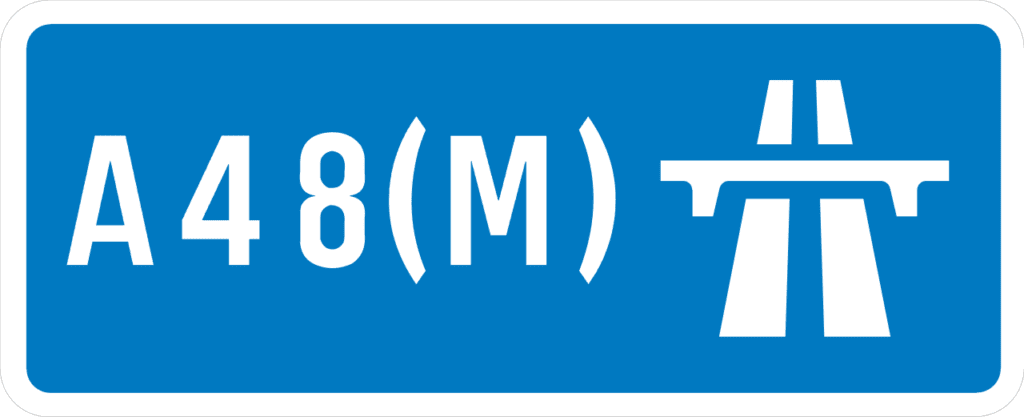
They are designed to be easily visible and understood at high speeds. Familiarise yourself with common motorway signs, such as those indicating variable speed limits, lane use, and hazard warnings.
Compliance with Traffic Laws
Strict compliance with traffic laws is non-negotiable on motorways. This includes adhering to speed limits, following lane usage rules, and obeying all signs and signals.
Traffic laws are in place to ensure the safety of all road users and to maintain order on the roads.
Non-compliance can result in fines, penalty points, or more severe consequences, such as disqualification from driving.
Understanding Different Types of Signs
Motorways feature various types of signs, each with a specific purpose. These include:
- Regulatory signs: Indicate laws that must be obeyed (e.g., speed limit signs).
- Warning signs: Alert drivers to potential hazards (e.g., sharp bends, roadworks).
- Information signs: Provide useful information (e.g., service stations, exits).
- Variable message signs: Electronic signs that provide real-time information about traffic conditions, speed limits, and lane closures.
Understanding these signs and their meanings will help you navigate motorways more safely and efficiently.
Speed on the Motorway
National Speed Limits
The national speed limit for cars on motorways in the UK is 70 mph. For vehicles towing trailers and larger goods vehicles, the limit is 60 mph.
These limits are set to ensure the safety of all road users and to maintain a consistent flow of traffic.
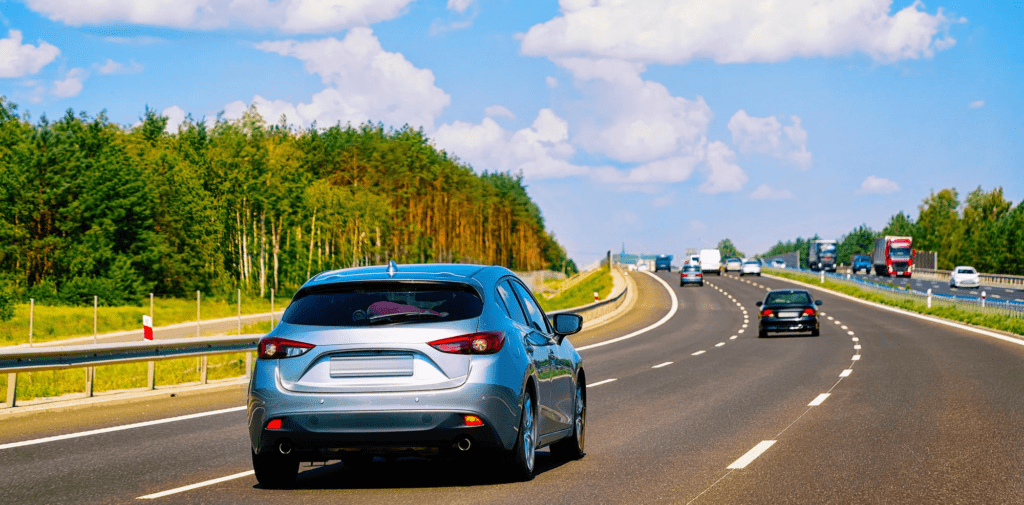
Always be aware of the speed limit for your specific vehicle and adhere to it at all times.
Variable Speed Limits
Variable speed limits are implemented on some motorways to manage traffic flow and reduce congestion.
These limits can change depending on:
- Traffic conditions
- Weather
- Roadworks and are displayed on overhead gantries.
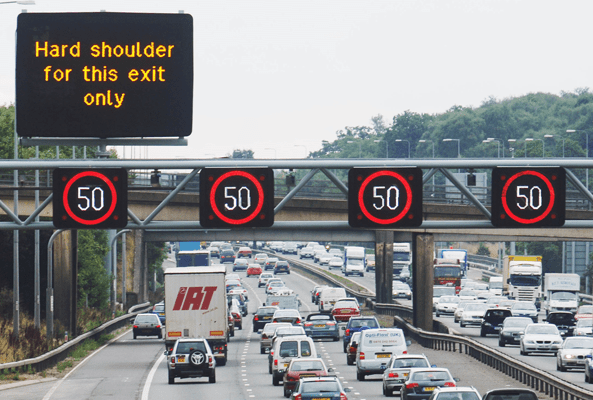
It is essential to comply with these variable limits as they are legally enforceable. They help in smoothing traffic flow and reducing the likelihood of accidents.
Speed Limit Enforcement
Speed limits on motorways are enforced through various means, including speed cameras and police patrols.
Average speed cameras are commonly used on stretches of roadworks or where variable speed limits are in place.

These cameras calculate your average speed over a distance and issue fines if you exceed the limit.
Additionally, mobile speed cameras and marked police vehicles can be deployed to monitor speed compliance.
Adjusting Speed for Conditions
While it is important to adhere to the posted speed limits, there are times when you need to adjust your speed according to road conditions.
In adverse weather conditions, such as rain, fog, or snow, you should reduce your speed to maintain control and ensure a safe stopping distance.
Similarly, if traffic is heavy or there are roadworks, slower speeds might be necessary.
Penalties for Speeding
Speeding penalties in the UK can be severe. If caught exceeding the speed limit, you may receive a Fixed Penalty Notice (FPN), which typically includes a fine and penalty points on your licence.
Accumulating 12 or more points within three years can result in disqualification from driving.
In more serious cases, such as excessive speeding or repeat offences, you may be:
- Prosecuted in court
- Facing higher fines
- More penalty points
- Even a driving ban
Smart Motorways
Definition of Smart Motorways
Smart motorways are a type of motorway in the UK designed to manage traffic flow more efficiently using technology.
They incorporate various systems to monitor and control traffic, with the aim of reducing congestion and improving journey times.
These motorways use dynamic traffic management techniques, such as variable speed limits and hard shoulder running, to make better use of available road space.
Types of Smart Motorways
There are three main types of smart motorways:
- Controlled Motorways: These have variable speed limits and use technology to manage traffic flow, but the hard shoulder is used only in emergencies.
- Dynamic Hard Shoulder Running: On these motorways, the hard shoulder can be opened to traffic at peak times or when there is congestion. Signs above the lanes indicate when the hard shoulder is in use.
- All Lane Running: On these motorways, the hard shoulder is permanently converted into a running lane. Emergency refuge areas are provided at regular intervals for breakdowns or emergencies.
Benefits of Smart Motorways
Smart motorways offer several benefits:
- Reduced Congestion: By using variable speed limits and opening up the hard shoulder, smart motorways can reduce traffic bottlenecks and smooth out traffic flow.
- Improved Journey Times: By managing traffic more effectively, smart motorways can lead to more predictable journey times.
- Increased Capacity: Converting the hard shoulder into a running lane increases the number of lanes available for traffic, accommodating more vehicles without the need for additional road building.
- Enhanced Safety: The use of technology to monitor and manage traffic can help to reduce the risk of accidents and improve overall road safety.
Technology Used in Smart Motorways
Smart motorways rely on various technologies to function effectively:
- Variable Message Signs (VMS): These electronic signs provide real-time information to drivers about speed limits, lane closures, and other important updates.
- Automatic Number Plate Recognition (ANPR) Cameras: These cameras monitor traffic flow and enforce speed limits.
- Radar and Loop Detectors: These sensors monitor traffic speed and density, providing data to the control centre.
- Emergency Refuge Areas (ERAs): These are designated areas where vehicles can stop in case of breakdowns or emergencies.
When driving on a smart motorway, it’s crucial to pay attention to the variable message signs and adhere to the displayed speed limits.
Always stay in the appropriate lane and be aware of lane closures or changes in lane usage, particularly the use of the hard shoulder as a running lane.
In case of a breakdown, use the emergency refuge areas if available, or move to the hard shoulder and use the emergency phone to alert the authorities.
Safety Tips for Motorway Driving
Maintaining a Safe Distance
One of the most important safety tips for motorway driving is to maintain a safe distance from the vehicle in front.
The two-second rule is a useful guide: ensure there is a two-second gap between you and the car ahead.
This gap should be increased in adverse weather conditions, such as rain, fog, or snow, to account for longer stopping distances.
Dealing with Heavy Traffic
Heavy traffic on motorways can be stressful, but staying calm and patient is key.
Keep a steady pace and avoid constant lane changes, as these can cause further congestion and increase the risk of accidents.
Maintain a safe following distance and be prepared for sudden stops. Use your mirrors frequently to stay aware of the traffic around you.
Handling Breakdowns
If your vehicle breaks down on the motorway, follow these steps:
- Move to the Hard Shoulder: If possible, move your vehicle to the hard shoulder. Ensure your vehicle is as far to the left as possible and angle your wheels towards the grass verge.
- Turn on Hazard Lights: Use your hazard lights to alert other drivers to your situation.
- Exit the Vehicle Safely: Leave the vehicle through the passenger side and move away from the road. Stand behind the barrier if there is one.
- Use an Emergency Phone: If you are near an emergency refuge area, use the emergency phone to call for assistance. Otherwise, use your mobile phone to contact the authorities, providing your exact location.
Use of Hazard Lights
Hazard lights are an important safety feature that should be used in specific situations.
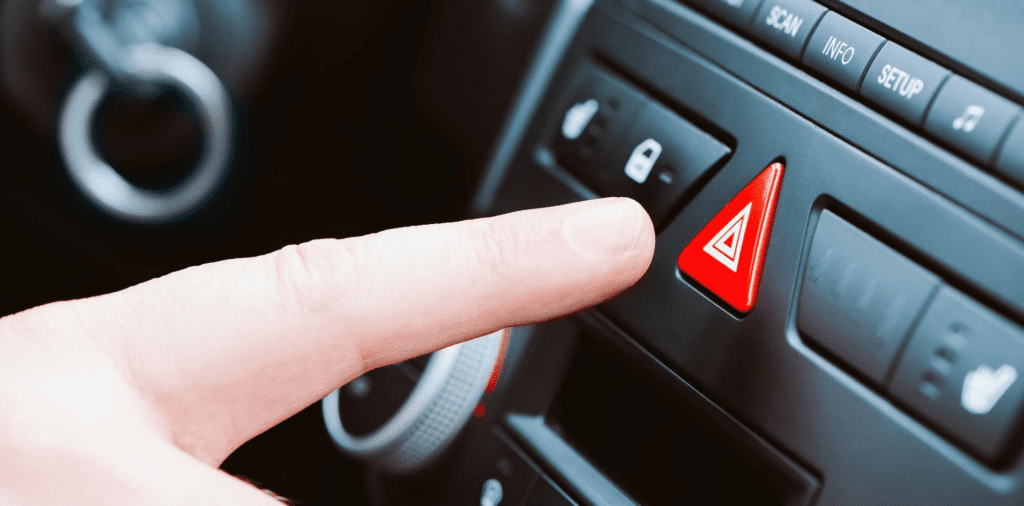
Turn on your hazard lights if you need to warn other drivers of a hazard or obstruction ahead, such as a breakdown, an accident, or sudden traffic stoppages.
Ensure to turn them off once the hazard has been dealt with or when you resume normal driving.
Emergency Phones and SOS Areas
Motorways are equipped with emergency phones and SOS areas to provide assistance in case of a breakdown or emergency.
Emergency phones are usually located at regular intervals along the hard shoulder or in emergency refuge areas on smart motorways.
These phones connect directly to a control centre, where help can be dispatched quickly.
When using an emergency phone, stand behind the barrier while making the call and provide clear details about your location and the nature of the emergency.
Common Hazards on the Motorway
Roadworks and Lane Closures
Roadworks and lane closures are common on motorways and can significantly affect traffic flow.
These areas are usually well-signposted with warning signs and reduced speed limits. It’s crucial to stay alert and follow the instructions provided by road signs and any temporary traffic lights.
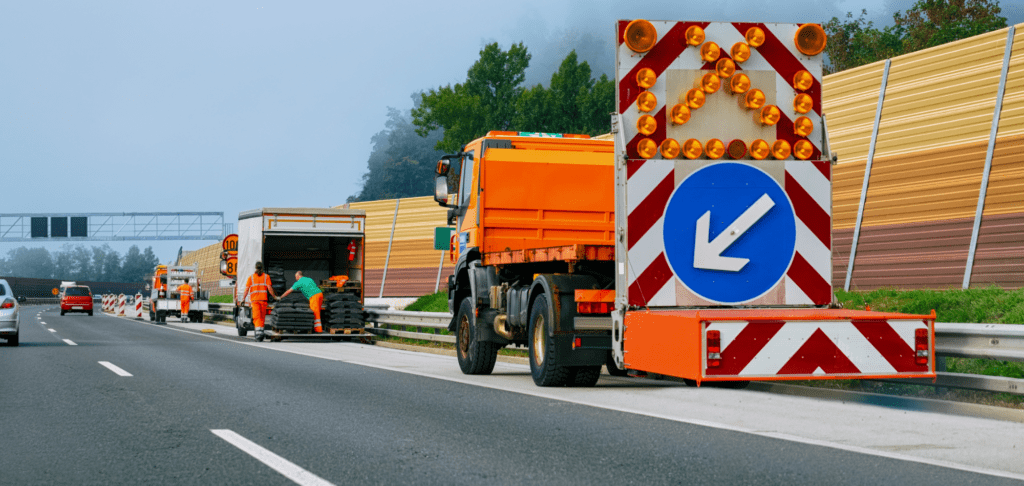
Keep a safe distance from the vehicle in front, as sudden stops may occur. Be prepared for narrower lanes and workers on the road.
Adverse Weather Conditions
Driving in adverse weather conditions such as rain, fog, snow, or ice requires extra caution.
Reduced visibility and slippery surfaces can increase the risk of accidents. When driving in such conditions, slow down and increase the distance between you and the vehicle in front.
Use your fog lights in heavy fog and dipped headlights in poor visibility. Avoid sudden braking or sharp turns, as these can lead to loss of control.
Debris and Obstructions
Debris and obstructions on the motorway can appear unexpectedly and pose serious hazards.
These can include anything from tyre fragments to larger objects that have fallen from vehicles. Always be vigilant and keep an eye on the road ahead. If you spot debris, try to avoid it safely.
Do not swerve suddenly, as this can cause you to lose control or collide with other vehicles.
Report any large obstructions to the authorities using an emergency phone if it’s safe to do so.
Aggressive Drivers
Aggressive drivers can be a significant hazard on motorways. These drivers may tailgate, weave between lanes, or exhibit road rage behaviours.
If you encounter an aggressive driver, remain calm and do not engage. Allow them to pass and maintain a safe distance.
If their behaviour poses a serious threat, consider reporting them to the authorities once it is safe to do so.
Fatigue and Long-Distance Driving
Fatigue is a major risk factor for accidents on motorways, especially during long-distance driving.
It’s important to take regular breaks, at least every two hours, to rest and refresh.
If you feel drowsy, find a safe place to stop, such as a service station, and take a short nap if necessary.
Avoid driving late at night or after a long day of activities. Stay hydrated and avoid heavy meals before or during your journey.
Overtaking on the Motorway
Rules for Overtaking
Overtaking on the motorway should be done with care and consideration of other road users. The Highway Code provides clear rules for overtaking:
- Only overtake on the right.
- Ensure the lane is clear before moving out.
- Signal your intention to overtake in good time.
- Do not cut back in too soon after overtaking.
Safe Overtaking Techniques
Safe overtaking techniques involve careful planning and execution. Before overtaking, check your mirrors and blind spots to ensure there are no vehicles approaching from behind.
Accelerate smoothly and move into the overtaking lane. Do not exceed the speed limit, and keep a safe distance from the vehicle you are overtaking.
Returning to Your Lane
Once you have overtaken the vehicle, you need to return to your lane safely. Check your mirrors and blind spot to ensure the lane is clear.
Signal your intention and move smoothly back into the left lane. Make sure there is enough space between you and the vehicle you overtook before moving back.
Overtaking Large Vehicles
Overtaking large vehicles such as lorries or buses requires extra caution. These vehicles have larger blind spots and may not see you as easily.
Start your overtaking manoeuvre from a greater distance and complete it as quickly as safely possible.
Be prepared for the possibility of crosswinds when overtaking large vehicles, as these can affect your vehicle’s stability.
Dealing with Vehicles Overtaking You
When a vehicle is overtaking you, maintain a steady speed and allow them to pass safely. Do not accelerate or swerve.
If you are in the middle or right lane and are being overtaken on the left, it is a sign that you should move back to the left lane as soon as it is safe to do so.
Be mindful of your surroundings and always use your mirrors to stay aware of traffic flow.
Exiting the Motorway
Planning Your Exit
Planning your exit from the motorway is an essential part of your journey. Always be aware of your intended exit and the distance remaining to reach it.
Motorway signs will typically indicate upcoming exits well in advance, allowing you to prepare.
Make use of your sat-nav or route planner to anticipate when and where you need to leave the motorway.
Keep an eye out for signs indicating the junction number and distance to the exit, which usually appear one mile, half a mile, and a few hundred yards before the actual exit.
Using the Exit Slip Road
When you approach your exit slip road, signal your intention to leave the motorway in good time.
This will inform other drivers of your planned manoeuvre. Move into the left lane well before your exit, ideally a mile or so in advance, to avoid last-minute lane changes.
As you enter the slip road, maintain a steady speed and be prepared to adjust according to traffic conditions.
Decelerating Safely
Decelerating safely is crucial when leaving the motorway. The slip road is designed to give you sufficient space to reduce your speed.
Start to decelerate once you are on the slip road, not while you are still on the main carriageway.
Pay attention to speed limit signs as these will often reduce significantly from motorway speeds.
Use your brakes gently to avoid sudden stops that could surprise drivers behind you.
After exiting the motorway, you will often encounter junctions or roundabouts. Approach these with caution, observing the appropriate road signs and markings.
Signal your intentions clearly and ensure you are in the correct lane for your intended direction.
Give way to traffic where required and merge smoothly into the new road. Be particularly vigilant for local traffic conditions, which may differ significantly from those on the motorway.
Common Mistakes to Avoid
Avoid common mistakes such as:
- Leaving it too late to signal: Always signal your intentions well in advance.
- Failing to move into the left lane in time: Plan your lane changes early to ensure a smooth exit.
- Braking suddenly on the motorway: Use the slip road to decelerate safely.
- Ignoring speed limits on the slip road: Adhere to speed limit signs to maintain control and safety.
Understanding Motorway Services
Purpose of Motorway Services
Motorway services provide essential facilities for drivers and passengers, offering a safe place to rest, refuel, and refresh during long journeys.
They help prevent driver fatigue, which is a significant risk factor for accidents on motorways.

Services are strategically located along major routes to ensure drivers have regular opportunities to stop.
Facilities Available
Motorway services offer a variety of facilities including:
- Fuel stations: For refuelling your vehicle.
- Food and drink outlets: Offering a range of meals, snacks, and beverages.
- Toilets: For necessary breaks and hygiene.
- Parking areas: For cars, lorries, and caravans.
- Shops: Selling travel essentials, magazines, and other goods.
- Accommodation: Some services provide hotel facilities for overnight stays.
- Electric vehicle charging points: For recharging electric cars.
Choosing When to Stop
It’s important to choose when to stop wisely. Plan your stops around every two hours to avoid fatigue.
Look out for signs indicating upcoming services and decide in advance where you will take your break.
Consider the needs of your passengers and the requirements of your vehicle. Avoid pushing through long stretches without a break, as tiredness can significantly impair your driving ability.
Parking Safely
When you arrive at a motorway service area, ensure you park safely. Follow the signs to the designated parking area for your type of vehicle.
Make sure you park within the marked bays and avoid blocking entrances or exits. If you are stopping for an extended period, choose a well-lit area and lock your vehicle securely.
Security Tips
Security is important when stopping at motorway services. Keep these tips in mind:
- Lock your vehicle: Ensure all doors and windows are securely locked before leaving your vehicle.
- Do not leave valuables visible: Store items out of sight, preferably in the boot.
- Be aware of your surroundings: Stay vigilant, especially at night or in less busy service areas.
- Use well-lit areas: Park in well-lit, busy areas where there is good visibility.
- Report suspicious activity: If you see anything unusual, report it to the service area staff or local authorities.
Dealing with Emergency Situations on the Motorway
Recognising Emergencies
Recognising an emergency situation on the motorway is crucial for taking appropriate action swiftly.
Emergencies can include:
- Serious vehicle breakdowns
- Accidents
- Medical issues
- Sudden hazards on the road
Be alert to any unusual sounds from your vehicle, changes in handling, or dashboard warning lights, as these could indicate potential problems.
Additionally, keep an eye out for other vehicles that may be in distress or erratic driving behaviour that could signal an emergency.

Immediate Actions to Take
In the event of an emergency, it is important to know the immediate actions to take:
- Move to Safety: If possible, move your vehicle to the hard shoulder or an emergency refuge area. Turn on your hazard lights to alert other drivers.
- Exit the Vehicle: If you are on the hard shoulder, exit the vehicle using the passenger side and move to a safe distance behind the barrier. Do not attempt to repair your vehicle on the hard shoulder.
- Stay Visible: Wear a high-visibility jacket if you have one, and ensure all passengers are visible and safe.
Contacting Emergency Services
When you have ensured your immediate safety, the next step is contacting emergency services.
Use your mobile phone or an emergency phone located at regular intervals along the motorway. Dial 999 and be prepared to provide essential details about your situation.
Providing Accurate Information
When speaking to emergency services, providing accurate information is crucial. Include:
- Your location: Provide specific details, such as the motorway number, the nearest junction, and any notable landmarks.
- Nature of the emergency: Describe whether it’s a vehicle breakdown, accident, medical emergency, or hazard on the road.
- Number of people involved: Mention how many people are with you and if anyone is injured.
This information helps emergency responders to reach you quickly and prepared for the situation.
Assisting Other Road Users
If you come across an emergency involving other road users, assisting them can be crucial:
- Ensure your own safety first: Do not put yourself in danger.
- Alert emergency services: If the situation hasn’t already been reported, call for help.
- Provide reassurance: Offer comfort and stay with the individuals involved until help arrives, if it is safe to do so.
Motorway Etiquette
Being Considerate to Other Drivers
Being considerate to other drivers is key to maintaining safety and smooth traffic flow on the motorway.
This includes allowing vehicles to merge from slip roads, not tailgating, and using your indicators to signal lane changes or exits well in advance.
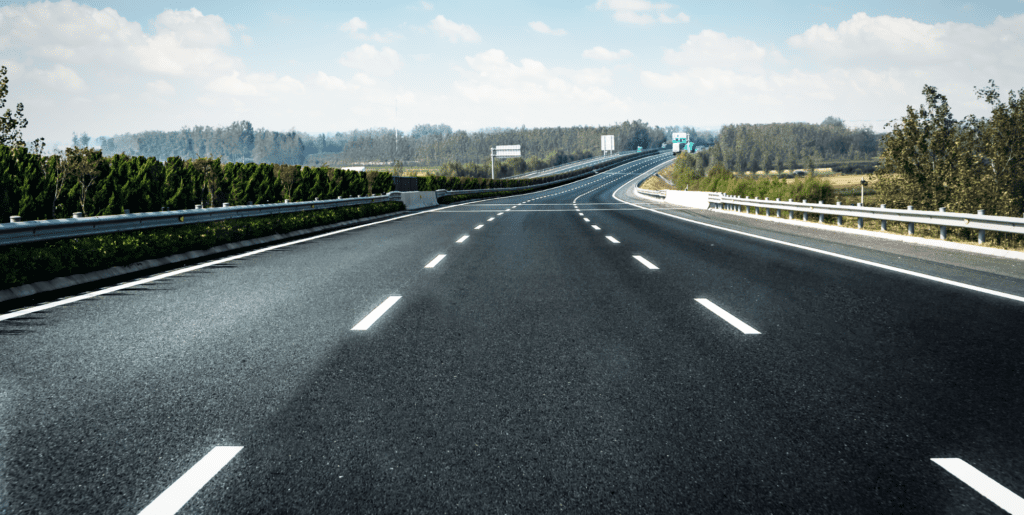
Avoiding Hogging the Middle Lane
Avoiding hogging the middle lane is an important part of motorway etiquette. Always return to the left lane after overtaking to keep the middle and right lanes clear for other vehicles needing to overtake.
Middle-lane hogging can cause unnecessary congestion and frustration among drivers.
Using Indicators Properly
Proper use of indicators is essential for safe motorway driving. Signal your intentions clearly and in advance to give other drivers enough time to react.
This includes signalling lane changes, exits, and when moving onto or off the hard shoulder.
Handling Tailgaters
Dealing with tailgaters requires calm and composed actions:
- Stay in your lane: Maintain a steady speed and do not brake suddenly.
- Move to a slower lane: If you are in the middle or right lane, move to the left lane when it is safe to allow the tailgater to pass.
- Do not engage: Avoid reacting aggressively, as this can escalate the situation.
Managing Slow-Moving Traffic
Managing slow-moving traffic on the motorway involves:
- Maintaining a safe distance: Keep a sufficient gap between you and the vehicle in front to allow for sudden stops.
- Avoid frequent lane changes: Constantly switching lanes can increase congestion and accident risk.
- Stay patient: Traffic jams are frustrating, but remaining calm and patient ensures your safety and that of others.
By understanding how to handle emergency situations and practicing good motorway etiquette, drivers can contribute to a safer and more efficient driving environment.
These practices not only enhance your safety but also improve the overall experience for all motorway users.
Fuel Efficiency on Motorways
Driving at a Consistent Speed
Maintaining a consistent speed is one of the most effective ways to improve fuel efficiency on motorways.
Constant acceleration and deceleration consume more fuel compared to a steady pace. Where possible, try to anticipate traffic flow and adjust your speed gradually.
Aim to keep your speed within the range that is optimal for your vehicle’s engine performance, typically around 55-65 mph for most cars.
Using Cruise Control
Cruise control can be a valuable tool for maintaining a consistent speed on motorways.
By setting a constant speed, cruise control helps to reduce unnecessary acceleration and braking, thereby saving fuel.

It is particularly useful on long, uninterrupted stretches of road. However, be cautious when using cruise control in heavy traffic or adverse weather conditions, where manual control may be safer.
Reducing Aerodynamic Drag
Aerodynamic drag significantly affects fuel consumption at higher speeds. Reducing drag can be achieved by:
- Removing roof racks and carriers when not in use, as they create additional resistance.
- Keeping windows closed: Open windows can increase drag, especially at higher speeds.
- Ensuring the vehicle is streamlined: Check that all body parts, such as bumpers and spoilers, are securely attached and undamaged.
Managing Acceleration and Braking
Smooth acceleration and braking are key to fuel-efficient driving. Rapid acceleration and harsh braking use more fuel.
Instead, accelerate gently and anticipate traffic conditions to brake smoothly. This not only saves fuel but also reduces wear and tear on your vehicle’s engine and brakes.
Monitoring Fuel Consumption
Regularly monitoring fuel consumption can help you understand your driving habits and make necessary adjustments.
Many modern vehicles are equipped with on-board computers that display real-time fuel efficiency.
Use this information to identify patterns in your driving that may be reducing fuel efficiency.
For older vehicles, you can track fuel consumption manually by recording mileage and fuel use at each fill-up.
Understanding Road Signs
Types of Motorway Signs
Motorway signs are crucial for safe and efficient driving. There are several types of motorway signs, each serving a different purpose:
- Information signs: Provide general information about the road ahead, including services, exits, and directions.
- Regulatory signs: Indicate laws and regulations that must be followed, such as speed limits and lane usage.
- Warning signs: Alert drivers to potential hazards, such as sharp bends, roadworks, or adverse weather conditions.
- Temporary signs: Used for roadworks, accidents, or other temporary conditions that affect normal traffic flow.
Download UK road signs PDF from the UK Government
Interpreting Information Signs
Information signs are designed to help drivers navigate the motorway and plan their journeys. These signs typically feature white text on a blue background and can include details such as:
- Distance to destinations: Indicating the number of miles to upcoming towns, cities, or motorway junctions.
- Service area locations: Showing the location and distance to the next service station.
- Junction numbers and exit lanes: Helping drivers prepare for their exits.
Regulatory Signs
Regulatory signs are crucial for maintaining order and safety on the motorway. These signs must be obeyed and include:
- Speed limit signs: Indicating the maximum permissible speed. Variable speed limit signs can change depending on traffic conditions.
- Lane usage signs: Such as those indicating lanes for specific types of vehicles or the end of a designated lane.
- No entry and prohibited actions: Signs indicating areas where certain actions, such as U-turns or lane changes, are not allowed.
Warning Signs
Warning signs alert drivers to potential hazards that may require caution. These signs are usually triangular with a red border and include:
- Sharp bends: Indicating a change in road direction.
- Merging traffic: Warning of lanes merging ahead.
- Adverse weather conditions: Signs indicating fog, ice, or high winds.
- Roadworks: Alerting drivers to construction zones with possible lane closures or speed reductions.
Temporary Signs
Temporary signs are used to manage traffic during roadworks, accidents, or other temporary situations. These signs are often portable and may be placed on the roadside or mounted on vehicles. Key types include:
- Temporary speed limits: Indicating reduced speed limits in construction zones.
- Lane closures: Signs indicating that a lane is closed ahead.
- Diversion routes: Providing alternative routes when sections of the motorway are closed.
By understanding and correctly interpreting these signs, drivers can navigate motorways more safely and efficiently.
This knowledge is essential for anticipating changes in road conditions, complying with traffic regulations, and ensuring a smooth journey.
Preparing for Long-Distance Journeys
Planning Your Route
Planning your route is crucial for a successful long-distance journey. Use reliable mapping tools or a sat-nav to determine the best path to your destination.
Plan for potential delays and alternative routes in case of roadworks or accidents.

Knowing your route in advance reduces stress and helps you manage your time more efficiently. Ensure you note important landmarks and service areas where you can take breaks.
Checking Your Vehicle
Before embarking on a long journey, it’s essential to check your vehicle to ensure it’s in good working order. Perform a thorough inspection, including:
- Tyres: Check the tread depth and pressure.
- Fluids: Ensure oil, coolant, brake fluid, and windshield washer fluid are at appropriate levels.
- Lights: Verify that all lights, including indicators and brake lights, are functioning.
- Brakes and Battery: Test your brakes and ensure the battery is fully charged.
- Emergency Kit: Carry an emergency kit that includes a first aid kit, warning triangle, high-visibility jacket, and basic tools.
Packing Essentials
When packing essentials for a long journey, consider both safety and comfort. Include:
- Snacks and Water: Keep hydrated and maintain energy levels.
- Navigation Aids: Maps or a sat-nav, and a charger for electronic devices.
- Personal Items: Medication, sunglasses, and any personal hygiene items.
- Entertainment: Music, audiobooks, or podcasts to keep you entertained during the drive.
- Clothing: Suitable clothes for varying weather conditions and comfortable driving shoes.
Managing Rest Breaks
Managing rest breaks is vital to prevent fatigue. Plan to take a break at least every two hours.
Use motorway service areas for rest, food, and toilet breaks. Stretch your legs and get some fresh air to stay refreshed.
If you feel drowsy, take a short nap before continuing your journey. Avoid driving for more than eight hours in a single day if possible.
Staying Alert and Focused
Staying alert and focused during long-distance driving is crucial for safety. Ensure you are well-rested before starting your journey.
Avoid heavy meals that can make you sleepy and stay hydrated. Use air conditioning or open a window to keep the cabin cool.
If travelling with others, engage in light conversation to stay awake, but keep distractions to a minimum.
Legal Requirements for Motorway Driving
Valid Licence and Insurance
Having a valid licence and insurance is mandatory for driving on motorways. Ensure your driving licence is up to date and appropriate for the vehicle you are driving.
Your vehicle must be insured, and you should carry proof of insurance with you. Driving without insurance is illegal and can result in severe penalties.
Vehicle Tax and MOT
Your vehicle must be taxed and have a valid MOT certificate if it is over three years old.
Ensure your tax is paid and the MOT is up to date before embarking on any journey.
Driving an untaxed or untested vehicle is illegal and can result in fines and penalties.
Restrictions on Learner Drivers
There are restrictions on learner drivers regarding motorway usage. Learner drivers in England, Scotland, and Wales can only drive on motorways if accompanied by an approved driving instructor and in a vehicle fitted with dual controls. Adhering to these restrictions is crucial for safety and legal compliance.
Understanding Penalties
Understanding the penalties for traffic violations on motorways is important for all drivers.
Common offences include:
- Speeding
- Using a mobile phone while driving
- Not wearing a seatbelt
Penalties can include fines, points on your licence, and disqualification from driving.
Ensure you are familiar with motorway regulations and adhere to them to avoid penalties.
Reporting Accidents
In the event of an accident, reporting it is a legal requirement. If you are involved in an accident, stop at the scene and exchange details with the other parties involved, including:
- Names
- Addresses
- Insurance information
If there are injuries or significant damage, you must report the accident to the police as soon as possible.
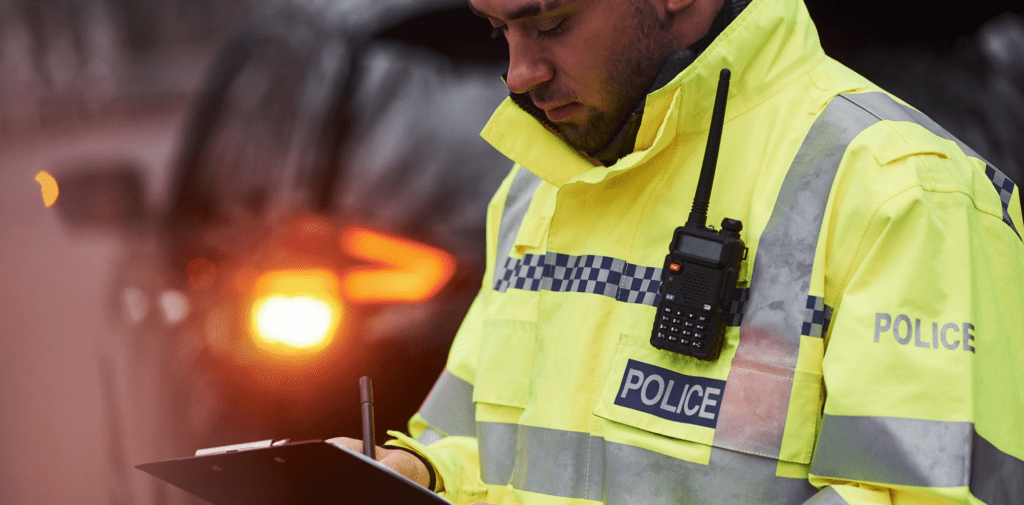
Use the emergency phones on the motorway to contact authorities if necessary.
Practicing Motorway Skills
Using Motorway Practice Sessions
Motorway practice sessions are an excellent way to develop your motorway driving skills in a controlled environment.
These sessions are typically part of an advanced driving course or can be arranged with a qualified driving instructor.

They allow you to experience motorway driving with professional guidance, helping you to understand the unique aspects of motorway navigation, such as merging, lane discipline, and using variable speed limits.
Working with an Instructor
Working with an instructor is particularly beneficial for new drivers or those lacking confidence on motorways.
An approved driving instructor can provide practical advice and feedback, tailored to your specific needs.
They can simulate various motorway scenarios, including joining and exiting, overtaking, and dealing with heavy traffic.
This hands-on experience is invaluable in building your skills and understanding motorway rules and etiquette.
Practicing in Different Conditions
Practicing in different conditions is crucial for becoming a competent motorway driver. Motorway driving can vary significantly depending on the time of day, weather, and traffic levels. Aim to practice during:
- Daytime and Night-time: Driving at different times helps you become accustomed to varying light conditions and traffic patterns.
- Peak and Off-Peak Hours: Experience the difference between busy and quieter times on the motorway.
- Adverse Weather: Practice in rain, fog, and other challenging weather conditions to improve your ability to handle reduced visibility and slippery roads.
Evaluating Your Progress
Regularly evaluating your progress is essential for continuous improvement. After each practice session, reflect on your experiences and identify areas where you felt confident and those where you need further practice.
Consider keeping a driving log to track your progress over time. Discuss your performance with your instructor to receive constructive feedback and set goals for future sessions.
Building Confidence
Building confidence on the motorway comes with practice and experience. Start with shorter journeys on familiar routes and gradually increase the length and complexity of your trips.
Stay calm and focused, and remind yourself of the skills and techniques you have learned.
Confidence is key to safe and effective motorway driving, and it grows as you become more comfortable with the various aspects of motorway navigation.
Frequently asked questions
Yes, but only if accompanied by an approved driving instructor in a vehicle fitted with dual controls. This rule helps ensure safety while allowing learners to gain valuable motorway driving experience.
The maximum speed limit for cars on UK motorways is 70 mph. For vehicles towing trailers and certain larger vehicles, the limit is 60 mph.
If you miss your exit, do not panic or make sudden manoeuvres. Continue to the next junction, exit there, and use the roads to return to your intended route safely.
Use the slip road to build up speed and match the flow of traffic on the motorway.
Check your mirrors and blind spots, signal your intention, and merge safely into the left lane.
Smart motorways use technology to manage traffic flow, including variable speed limits and lane control.
They may use the hard shoulder as an additional lane during busy periods to reduce congestion.
Variable speed limits are displayed on overhead gantries and can change depending on traffic conditions.
They help manage traffic flow and improve safety, and compliance with these limits is mandatory.
Lane discipline involves staying in the left lane unless overtaking.
It helps maintain a smooth flow of traffic and reduces the risk of accidents caused by unnecessary lane changes.
Use your hazard lights to warn other drivers of a hazard or obstruction ahead, such as a breakdown, accident, or sudden traffic stoppages.
Maintain a consistent speed, use cruise control where appropriate, reduce aerodynamic drag, manage acceleration and braking smoothly, and regularly monitor your fuel consumption.
Move to the hard shoulder or an emergency refuge area, turn on your hazard lights, exit the vehicle safely, and use an emergency phone to call for assistance.
Check your mirrors and blind spots, signal your intention, move into the overtaking lane smoothly, pass the slower vehicle, and return to the left lane when it is safe to do so.
Common hazards include:
- Roadworks
- Adverse weather conditions
- Debris
- Aggressive drivers
- Fatigue
Stay alert and prepared to manage these situations safely.
Plan rest breaks every two hours, stay hydrated, eat light snacks, use air conditioning or open a window for fresh air, and avoid driving when tired.
Ensure you have a valid licence, your vehicle is insured, taxed, and has a valid MOT. Learner drivers must follow specific restrictions, and all drivers must comply with traffic laws and regulations.
Report the accident using an emergency phone or your mobile if it’s safe and legal to do so.
Provide accurate information about the location and nature of the accident, and assist other road users if it is safe to do so.


